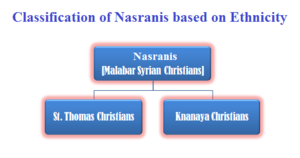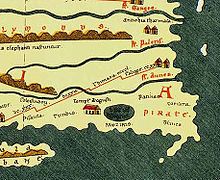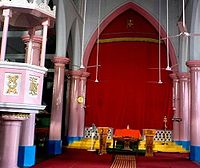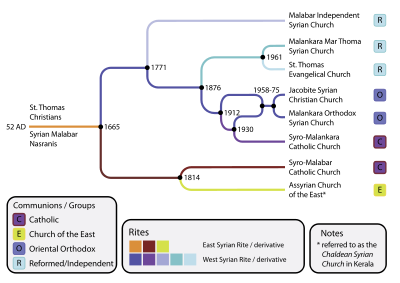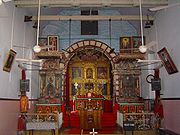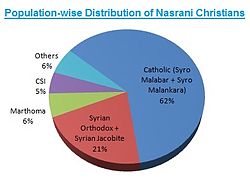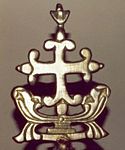- Syrian Malabar Nasrani
-
For other uses, see Nasrani (disambiguation).
- This article deals with the Nasrani People as an ethnic community, for a detailed article on the religious tradition of the Nasrani people; see: Saint Thomas Christians.
Syrian Malabar Nasranis Varghese Payapilly Palakkappilly · Gheevarghese Mar Gregorios of Parumala · Anna Chandy
P. C. Alexander · Abraham Verghese
· Asin ThottumkalTotal population Kerala: 6,000,000 (18% of Pop.)[1] Regions with significant populations  India
India
Religion Roman Catholicism, Oriental Orthodoxy, Marthoma Church, Protestantism (minority)
Related ethnic groups The Syrian Malabar Nasrani people, also known as Saint Thomas Christians, "'Nasrani Mappila'" and Nasranis, are an ethnoreligious group from Kerala, India, adhering to the various churches of the Saint Thomas Christian tradition. They are also known as Syrian-Malabar Christians, Suriyani Christiaanikal, Mar Thoma Nasrani, or more popularly as Syrian Christians, since they have been using a Syriac(classical form of Aramaic) liturgy since the early days of Christianity in India.
The Syrian Malabar Nasranis are the descendants of the local people [2][3][4][5][6][7][8][9][10][11][12][13] and Jewish diaspora in Kerala [14][15][16][17][18][19][20][21][22] who became Christians in the earliest days of Christianity in the Malabar Coast.[14][15][16][17][18][19] They own a unique liturgical system basically formed from the religious patronage extended from the Church of Persia which consists of many East Syrian and Hebrew Syriac Christian traditions blended with indigenous customs. Their liturgical heritage is Syriac-Keralite, their culture South Indian with Semitic and local influences, their faith St. Thomas Christian, and their language Malayalam.[14][15][16][17][18][19] Much of their East Syrian, indigenous and Jewish traditions have undergone latinization during the oppression by the Portuguese in the early 16th century.[14][15][16][17][18][19] The persecution of the Malabar Nasranis by the Portuguese in the analogue of the Spanish inquisition known today as the Portuguese Inquisition [14][15][16][23][24][25][26]
Contents
Terminology
Portuguese period
During the Portuguese power in Malabar (1679–1728) there were four distinctive sections of Christians in Kerala.[27][28]
- Syrian Christians. The Portuguese called them The Christians of St. Thomas.
- Syrian Christian Roman Catholics.
- The non-Syrian Roman Catholics converted to Catholicism by the Portuguese; known as Inland Christians by the Van Rheede [29] and New Christians by Moens.[30] They were grouped into seven parish churches under the bishop of Cochin.
- Topass Christians. (Thuppai). They were the descendents of Indian mothers or fathers belonging to the diverse European nations, e.g. Anglo-Indians.
Only the first two are Syrian Malabar Nasranis. Others are not.
Nasrani
The term Nasrani derives from the name Nazarene, means "Man from Nazareth". Tertullian (c.160–c.220, Against Marcion 4:8) records that the Jews called Christians "Nazarenes" from Jesus being a man of Nazareth (Acts 24:5).[31][32] This name could be seen in Quran also as nasara (plural of nasrani "Christians"). The Arabic word nasara (نَصارى) comes from the Arabic root "n s r" (ن ص ر). It is suggested that the term Nasrani was used essentially to denote Jewish followers of Jesus from Nazareth, while the term Khristianos "Christian" was initially used largely to refer to non-Jewish peoples ("gentiles") who followed the Christ (Acts 11:26).[14][15][16][33][34][35]
In some localities, Syrian Malabar Nasranis are also called Nasrani Mappilas.[36] But some historians believe that the title "Mappila" was honorarily given by the King to Thomas of Cana and after his arrival only, the Nasranis were started being called "Nasrani Mappilas".[37][38] There's a difference of opinion on the exact origin of the word Mappila (Moplah), but by and large it is considered to be derived from a combination of ancient Tamil/Malayalam Maha (great) or Ma (mother)[39] and Pillai ("Son-in-law" or "Bridegroom").[40][41] According to Hermann Gundert (who wrote the first Malayalam dictionary), the term 'mappila' was a title used to denote Semitic immigrants from West Asia.[36] The term "Mappila" represents miscegenation or Racial Admixture among Semitic people and indigenous people in the ancient coastal cities of Malabar.[42] It was used to specify like Jonaka Mappila or Nasrani Mappila to distinguish between Muslims and Syrian Christians,[36] since racial admixture of the native people took place among Muslims with Arabs and Syrian Christian with Jews.[43] Cochin Jews were no exception and were called "Juda Mappilas".[44]
History
Main article: History of the Saint Thomas Christian traditionOrigins
Syrian Christians in Kerala believe that St Thomas had implanted Christian belief in their ancestors along with the Christian community in Edessa.
In the 1st century AD, Kerala was predominantly ruled by Chera Dynasty and hence called Cherarajyam at that time. Muziris (now known as Pattanam near Cochin) was the important entry port. Around the early days of Christianity a multilingual and multi-cultural society was existent in Muziris in which indigenous as well as migrated West Asian Semitic people lived a harmonious life under the rule of Cheran Kings.
Semitic settlements in Muziris
In the Bible, there are inferences suggesting trade links of Semitic people with Malabar, especially for spices and luxury articles with Phoenicia as early as the period of King Solomon.[45] Excavations carried out at Pattanam in 2008 provided evidence that the maritime trade between Kerala and the Mediterranean ports existed back in 500 BC or earlier.[46] It is possible that some of those traders who arrived from the west, including some Jews, remained in Kerala.[47] While Augustus Caesar (31 BC- 14 AD) was the Emperor of Rome and Herod the Great (37–4 BC) was King of Judea, ambassadors from Malabar visited the Emperor Augustus.[48][49] There is a hypothesis that these ambassadors were The Wise Men From the East, of the Bible.[50][51] In the first century map Tabula Peutingeriana (see the map) a temple of Augustus is clearly visible near Muziris shows the close relation between Rome and Malabar in the first century BC.
The community also comprises several ancient Aramaic Christian settlements in Kerala. The Knanaya Nasranis claim to be the descendants of one such group of 4th century immigrants.[14][15][16][18][33][34]
The southern coast of the Indian subcontinent (hypothesized by the Jewish historian Flavius Josephus to be the place mentioned as Ophir in the Old Testament) inevitably became a gateway from the Mediterranean world to Kerala. The people there traded in teak, ivory, spices and peacocks, and the area was endowed with a magnificent coastline with numerous ports from Mangalapuram to Kodungallur, also known as Cranganore.[22][52] In the ancient times it was called as Muziris in Latin and Muchiri in Malayalam.[53][54][55]
The trade routes brought with them not just riches but also stateless nations and nascent worldviews.[56][57] Cranganore became one of the earliest settlements of the Jewish diaspora from the later Old Testament period. They continued trade with the Mediterranean world, thus establishing a strong link between the southern coast of the Indian peninsula and the Judeo-Roman world.[58][59][60] Laying the links or foundations for what would later be the early 'Judeo-Nazaraean' diaspora.[14][15][16][21]
The Tamil epic of Manimekkalai written between the 2nd and 3rd centuries AD of the Sangam Literature era mentions the Nasrani people by the name Essanuvadikal or Essanis referring to one of the early sects within the Nasranis called Essenes.[61] In AD 883, Alfred the Great (849–899), King of Wessex, England reportedly sent gifts to Mar Thoma Christians of India through Sighelm, bishop of Sherborne.[62] Around 1292 AD, Marco Polo (1254–1324) on his return journey from China visited Kerala, mentions that, "The people are idolaters, though there are some Christians and Jews among them".[63][64]
Thus the Semitic settlements as suggested above led the way to the ministry of disciples of Christ in Malabar as early as 1st century AD.
St. Thomas's Ministry in Kerala
Acts of Thomas hints that St. Thomas came to India with a Jewish trader. British researcher William Dalrymple travelled across the Arabian Sea to Kerala in a boat similar to those mentioned in Roman texts and showed how the traders had travelled from the Middle East to Kodungulloor. He followed the same course as mentioned in the Acts of Thomas, a copy of which survives in a monastery on Mount Sinai.[65][66][67] During that time the area from Syria to Patria was under Roman rule and because of this traveling through this region was relatively easy.[68] His name is mentioned as Haban and it is believed that both reached Kodungalloor(Krankanoor) in AD 52. Over here he stayed 1st with the Jewish community, preached the Gospel and evangelized them. The tradition is that ST. Thomas established the Ezharappallikal (ഏഴരപള്ളികള്), or "The Seven and Half Churches" in Kerala. These churches are at Kodungallur, Kollam, Niranam, Nilackal (Chayal), Kokkamangalam, Kottakkayal (Paravoor), Palayoor (Chattukulangara) and Thiruvithancode Arappally – the half church. These communities were multi-ethnic as they were selected from an enlightened resident communities of the then Kerala including local people and migrated Jews. Thus the present Christian community of Kerala consists of people from many descents including native Indians of Aryan, Dravidian and Naga ethnicity who could have been baptized by ST. Thomas as well as different trading diaspora of Jews and Christian settlers of successive centuries like Knanaya people.[14][16][18][19][33][34][69]
Epigraphy
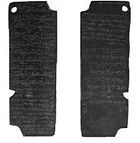 Front and Reverse of third Quilon copper plate with Pahlavi, Kufic and Hebrew signatures.
Front and Reverse of third Quilon copper plate with Pahlavi, Kufic and Hebrew signatures.
The Rulers[who?] gave the Nasranis various rights and privileges which were written on copper plates. These are known as Cheppeds, Royal Grants, Sasanam etc.[74]
There are a number of such documents (Thazhekad Sasanam, The Quilon Plates (Tharisappalli Cheppeds), Mampally Sasanam and Iraviikothan Chepped (Copper Plate) etc.) in the possession of the Syrian Churches of the Kerala State. Some of these plates are said to be dated around 774 AD. Dr. Burnell, Burkatt F C, Sir Baily Harold, C P T Wenkwirth studied the inscriptions and produced varying translations. The language used is Tamil in Tamil letters with some Grantha script intermingled . In Quilon Copper Plates which was given to Mar Sapor and Mar Prodh who immigrated to Quilon from Persia in 823 AD include some Pahlavi, Kufic and Hebrew signatories.[4]
The ruler of Venad (Travancore) granted Syrian Christians seventy two rights and privileges usually granted only to high dignitaries, including exemption from import duties, sales tax and the slave tax. A copper plate grant dated AD 1225 further enhanced the rights and privileges of Nasranis.
These plates detail privileges awarded to the community by the then rulers. These influenced the development of the social structure in Kerala and privileges, rules for other communities such as Jews at a later date. These are considered as some of the most important legal documents in the history of Kerala.[75]
Socio-Cultural and religious identity
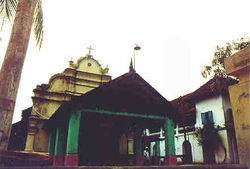 An old church in Kerala
An old church in Kerala
St.Thomas Christians had an identity of their own. Though their liturgy and theology remained that of East-Syrian Christians of Persia, their life-style customs and traditions were basically Indian. It is oft-quoted - "Nazranis are Keralite in culture, Christian in faith and Syrian in liturgy"[76]
Due to the common Apostolic origin and a number of socio cultural factors, from a very early period the Church of St. Thomas Christians came in to a life long relationship with the Church of Persia. According to early Christian writings Church of Persia was also established by St. Thomas the apostle. The Primate of Persia was consecrated Metropolitan of Great India as per the attestation of the Council of Nicea in 325. Primate or Metropolitan of Persia consecrated bishops for the Indian Church of St. Thomas Christians. This relation caused to form the liturgical system of Malabar Christians, closely aligned with that of Persian Church and thus the Malabar Christians following Syrian Liturgy were called Syrian Christians of Malabar.[5]
Presence of Jews in the early Christians had significant effects on the liturgy and traditions of the entire community. The community maintained some of the original rituals of the early Jewish Christians, such as covering their heads while in worship. Their ritual services was and still is called the Qurbana (also spelled Kurbana), which is derived from the Aramaic and Hebrew term korban (קרבן), meaning "sacrifice". The Nasrani Qurbana used to be held in Syriac.
As far as the cultural identity of Syrian Christians is considered, they typically followed the social customs of their Hindu fraternity.[77] The vestiges of Hindu symbolism could be seen in their devotional practices too.[78] Social sins like Untouchability entered their practices and Synod of Udayamperoor abolished it vide Section IX of Decree 2.[77] The rituals related to birth, Vidyarambham, marriage, pregnancy, death etc. were also similar in both the communities.[77] Now also, tying Thaali, a Hindu symbol of marriage is the most important rite in the Christian marriages too. They used to learn temple arts like Kathakali, Kooth and Thullal and their own art forms like Margam Kali and Parichmuttu Kali have resemblance to Yathra kali Pattu of Brahmins in Kerala.[77] In 1519, a Potugese traveller Duarte Barbosa on his visit to Malabar commented on the practice of Syrian Christian priests using Kudumi similar to that of Brahmins, in his manuscript "Book of Duarte Barbosa".[79]
Part of a series on Christianity
in India
Background People - St. Thomas the Apostle
- St. Francis Xavier
- St. Gonsalo Garcia
- Devasahayam Pillai
- St. Alphonsa Muttathupadam
- Thomas of Cana
- Mother Teresa
- Palackal Thoma Malpan
- Mar Augustine Kandathil
- Mar Sapor and Prodh
- Marthoma Metrans
- St. Gregorios of Parumala
- St. Baselios Eldho
- Fr. Kuriakose Elias Chavara
- Fr. Varghese Payapilly Palakkappilly
- Mgr. Joseph C. Panjikaran
- William Carey
Churches - St. Thomas Christians:
- Malankara (historical)
- Chaldean Syrian
- Jacobite Syrian
- Malankara Orthodox Syrian
- Malabar Independent Syrian
- Mar Thoma
- St. Thomas Evangelical
- Syro-Malabar Catholic
- Syro-Malankara Catholic
- Latin Rite:
- Latin Catholic
- Protestant denominations:
- Andhra Evangelical Lutheran
- Church of North India
- Church of South India
- Garo Baptist
- Pentecostal Church of God
- North Bank Baptist Christian
- Northern Evangelical Lutheran
- Presbyterian
- The Pentecostal Mission
- Seventh-day Adventist
- True Jesus
- United Evangelical Lutheran
Indian Christianity portal Persecution by Portuguese
Further information: Goa InquisitionFurther information: Portuguese InquisitionA Syro-Malabar Catholic Church in Kerala, with the Holy of Holies containing the Nasrani Menorah or Mar Thoma Sliba (St. Thomas Cross) veiled by a red curtain in the tradition of ancient Jewish synagogue.
The original tradition of the Syro-Malabar Nasranis was wiped out when the Portuguese invaded Kerala, and denounced the Nasrani account of Christian faith as false. They imposed their European rituals and liturgy and obliterated the Indian legacy from the Nasrani tradition.[23] In 1578, three lay leaders of the Kerala Nasranis submitted a petition to Pope Gregory XIII, saying, “Our orations are in Syriac or Chaldeae language which our Father St. Thomas gave us. We as well as our ancestors have learned this language.”[80]
Archbishop Menezes of Goa, convened the Synod of Diamper in Kerala in 1599.[14][15][16][24] There he ordered all the texts of the Syrian Nasranis to be burnt.[14][15][16][25] The Portuguese burned several of these texts. The purpose stated by Menezes was to erase all legacies of antiquity and Jewishness.[23] Amongst several accusations, the Nasranis were accused of not venerating images of saints and Biblical figures.[23] They completely obliterated the records of early Nasrani life and tradition.[66][67]
Books ordered to be destroyed:[81]
General books destroyed: (1) Prammasa (2) Johannan Para Kalthon (3) Maarganisa (4) Vaappkadey Pusthakam (5) Aava Eilayya (6) Nuhara (7) Sunahadosa (8) Mar theermathay Osa (9) Njayarazhchayuday Emgartha (10) Makammasa (11) Kaamessa (12) Parapumman (13) Suryaniyile Malpanmaruday Pusthakangal (14) Peshitta. Worship books destroyed: (1) Hoodara (2) Sumaday Pusthakam (3) Annadha Pusthakam.
Nasranis outside the region of Portuguese control managed to preserve some elements of their original books. It was one of these books that Mar Thoma VI handed over to Dr. Buchanan in 1806.
Most of all, the Portuguese destroyed the Malabar Nasrani Syriac Peshitta known today as the Lost Aramaic Bible, and whose Old Testament section included sections based on Jewish Targum (an Aramaic translation of the Hebrew Bible). Several elements of Hebrew Syriac Christianity was lost due to Portuguese Inquisition.[23] However, the Knanaya people preserved some elements of their Jewish heritage because of their tradition of being endogamous within their own community.[33][34][82][83][84]
Division and defiance
The oppressive rule of the Portuguese padroado provoked a violent reaction on the part of the indigenous Christian community. The first solemn protest took place in 1653, known as the Koonan Kurishu Satyam (Koonan Cross Oath). Under the leadership of Archdeacon Thomas, Saint Thomas Christians publicly took an oath in Matancherry, Cochin, that, "by the Father, Son and Holy Ghost that henceforth we would not adhere to the Franks, nor accept the faith of the Pope of Rome".[85] (The Missionary Register for 1822 seems to be the earliest reliable document available from within the Nasrani tradition). Four months after this event according to their ancient tradition 12 elders of the church laid their hands on Malankara Mooppen Thomas and ordained him as Mar Thoma I. The branch affiliated with Catholic Church was designated the Pazhayakuttukar, or "Old Party", while the branch affiliated with Mar Thoma was called the Puthankuttukar, or "New Party".[86][87][88][89] These appellations have been somewhat controversial, as both groups considered themselves the true heirs to the Saint Thomas tradition, and saw the other as heretical.[90]
After the Coonan Cross Oath, between 1661 and 1662, out of the 116 churches, the Catholics claimed eighty-four churches, and Archdeacon Mar Thoma I with thirty-two churches. The eighty-four churches and their congregations were the body from which the Syro-Malabar Catholic Church and Chaldean Syrian Church have descended. The other thirty-two churches and their congregations were the body from which the Syriac Orthodox (Jacobites & Orthodox), Thozhiyur (1772), Mar Thoma (Reformed) (1874), Syro-Malankara Catholic Church have originated.[91] In 1665, Mar Gregorios Abdul Jaleel, a Bishop send by the Syriac Orthodox Patriarch of Antioch arrived in India and the St.Thomas Christians under the leadership of the Archdeacon welcomed him.[92][93] This visit resulted in the Mar Thoma party claiming spiritual authority of the Antiochean Patriarchate and gradually introduced the West Syrian liturgy, customs and script to the Malabar Coast.
The arrival of Mar Gregorios in 1665 marked the beginning of a formal association of St.Thomas Christians with the West Syrian Church. Those who accepted the West Syrian theological and liturgical tradition of Mar Gregorios became known as Jacobites. Those who continued with East Syrian and Latin theological and liturgical tradition and stayed faithful to the Synod of Diamper and the Roman Catholic Church are known as the Syro-Malabar Catholic Church in communion with the Catholic Church. They got their own Syro-Malabar Hierarchy on 21 December 1923 with the Metropolitan Mar Augustine Kandathil as the Head of their Church.
Further divisions
In 1772, the West Syrians under the leadership of Kattumangattu Abraham Mar Koorilose, Metropolitan of Malankara, formed the Malabar Independent Syrian Church (Thozhiyur Sabha).[92]
In 1836, in protest against the acknowledgment of the jurisdiction of the Jacobite Patriarch at the Synod of Mavelikara, some Syrian Orthodox families left in protest and regard themselves as Anglo-Syrians or Syrian Anglicans in the sense that they see themselves as exclusive from other members of the Church of South India to which denomination they now belong. As a result of this particular history, they are more likely to seek marriage partners from among themselves or from the Mar Thoma or Syrian Orthodox churches rather than from among non-Syrian members of their own denomination. The Syrian Anglicans within the Church of South India thus predate the emergence of the Mar Thoma Church by four decades.
In 1876, those who did not accept the authority of the Patriarch of Antioch remained with Thomas Mar Athanasious and chose the name Malankara Mar Thoma Syrian Church. They removed a number practices introduced at The Synod of Diamper to the liturgy, practices and observances.
In 1961, there was a split with the formation of St. Thomas Evangelical Church from the Marthoma Church.
However, in 1912 due to attempts by the Antiochean Patriarch to gain temporal powers over the Malankara Church, there was another split in the West Syrian community when a section declared itself an autocephalous church and announced the re-establishment of the ancient Catholicosate of the East in India. This was not accepted by those who remained loyal to the Patriarch. The two sides were reconciled in 1958 but again differences developed in 1975. Today the West Syrian community is divided into Malankara Orthodox Syrian Church (in Oriental Orthodox Communion, autocephalous), Jacobite Syriac Orthodox Church (in Oriental Orthodox Communion, under Antioch).
In 1926 a section of West Syrians under the leadership of Mar Ivanios came into communion with the Catholic Church, retaining all of the Church’s rites, Liturgy, and autonomy. They are known as Syro-Malankara Catholic Church.
Nasrani people today
Part of a series on Nasrani
people
Though part of the unique local tradition was lost, some of its distinct traditions and observances lived on. A surviving Jewish tradition is the tradition of Pesaha-appam or unleavened Passover bread. On passover night, the Nasrani people have Pesaha-appam along with Pesaha-pal or "Passover coconut milk". This tradition of Pesaha-appam is observed by many Nasrani people until this day.
The Nasrani Church has a separate seating arrangement for men and women. Until the 1970s the Nasrani kurbana was sung in Syriac. Many of the tunes of the Syriac Christian worship in Kerala are remnants of ancient Syriac tunes of antiquity.[94] The "Holy of Holies" is divided by a red curtain for most of the time and is opened during the central part of the Nasrani Mass or Qurbana in the hagbah. The Nasrani Baptism is still called by the Aramaic term mamodisa and follows many of the ancient rituals of the ceremony. It is referred to in Malayalam as Njana Snanam ("Bath of Wisdom").
By and large, today's Nasrani people belong to one or the other of the various Christian denominations of the Saint Thomas Christian tradition.
Demographics
Nasrani people largely live in the districts of Pathanamthitta, Alapuzha, Kottayam, Idukki, Ernakulam and Trichur in Kerala. They have also migrated to other cities in India like Kanyakumari, Ooty, Mangalore, Bangalore, Chennai, Pune, Delhi, Shimoga, Mumbai, Coimbatore, Hyderabad and Kolkota. Others have migrated to the United States, Europe, Australia or work in the Middle East. Based on the Indian census report of 2004, there are presently approximately 6,000,000 Syrian-Malabar Nasranis from across the various denominations within the Nasrani community.[95] The Syro Malabar Catholic Church and the Syro-Malankara Catholic Church together constitute about 51.4%, the Syrian Orthodox and Syrian Jacobites together about 21.4%, the Mar Thoma Christians about 15.7%, the Church of South India 5.2% and others about 6.3% of Christian in the state.[96]
Many Nasrani people own large estates and engage in trade of rubber, spices and cash crops. They also take a prominent role in the educational institutions of Kerala and throughout India.[26]
Church leaders fear that increasing migration and decreasing birth rate are endangering the Syrian Christian community in Kerala. They also fear that the situation is likely to worsen in the coming decades and the community would soon enter the zero population regime.[97][98]
Nasrani symbol
The symbol of the Nasranis is the Mar Thoma Cross, Mar Thoma Kurish, Nasrani Menorah or Mar Thoma Sleeba[99] മാര്ത്തോമാ ശ്ലീബാ in Malayalam. There are several interpretations for the Nasrani Symbol. The interpretation based on Christian Jewish tradition assumes that The Mar Thoma Sleeba's design was based on Jewish menorah, an ancient symbol of the Hebrews, which consists of seven branched lamp stand (candelabra). (Exodus 25).[100][101]
The interpretation based on local culture states that the Cross with out the figure of Jesus and with flowery arms symbolizing "joyfulness" points to the resurrection theology of St. Paul, the Holy Spirit on the top represents the role of Holy Spirit in the resurrection of Jesus Christ. The lotus symbolizing Buddhism and the Cross over it shows that Christianity was established in the land of Buddha. The 3 steps indicate Calvary and the rivulets, channels of grace flowing from the Cross.[102]
Note that the Christian cross was not adopted as a symbol by Mediterranean and European Christianity until several centuries had passed.
Traditions, rituals and social life among Syrian Christians
- Women cover their heads during worship, even outside the church.[citation needed]
- The ritual services (liturgy) is called the Holy Qurbana (or kurbana), which is derived from the Hebrew Korban (קרבן), meaning "sacrifice".
- Some parts of the Nasrani Qurbana are sung in Syriac.
- Pesaha, the ritual supper which is the narration of the Paschal event is celebrated among Saint Thomas Christians. The observance of Pesaha at home is an unbroken[citation needed] tradition which is unique to the Saint Thomas Christians among Christians in India.[citation needed]
- Immediately after a Child is born, a priest or male relative shouts in the child’s ear Maron Yesu Mishiha ( Jesus Christ is the Messiah ) and the child would be fed with three drops of honey in which a little gold had been rubbed.[103][104]
- Another surviving tradition is the use of muthukoda (ornamental umbrella) for church celebrations, marriages and other festivals. Traditional drums and arch decorations and ornamental umbrella are part of the church celebrations. Its use have become popular all over Kerala.
- Boundaries between Christians and Hindus are blurred in some cultural sphere such us house building, astrology, birth and marriage ( use of sandalwood paste, milk, rice and areca nut)[105]
- The spiritual life of Nasranis is ordered by liturgical obligations and by its specifically Christian ethics. Death rituals express Christian canonical themes very distantly and the influence of Hindu culture is quite noticeable. Much stress is given to ideas concerning life after death and the anticipation of final judgment.[105]
- Christians were given honorific titles. Tharakan is a word derived from the word for tariff.Panikkar denotes proficiency in military training.[106][107]
- Syriac Christians do not marry close relatives. The rule is that bride and groom must not be related for at least five generations. Entering into marriage relationship in the Mar Thoma Church is possible only if there are five generations, between the common ancestor and the prospective parties i.e. marriage between third cousins is permissible.[108]
- Syrian Christians didn't use any pictures, paintings or statues of Jesus or saints in their churches until the arrival of Portuguese. They considered it as idolatry.[109]
Caste status
Syrian Malabar Nasranis or Syrian Christians are considered forward caste in India. They tend to be endogamous, and tend not to intermarry even with other Christian castes.[110]
Syrian Christians derive status within the caste system from the tradition that they were elites, who were evangelized by St. Thomas.[111]
Anthropologists have noted that the caste hierarchy among Christians in Kerala is much more polarized than the Hindu practices in the surrounding areas, due to a lack of jatis. Also, the caste status is kept even if the sect allegiance is switched (i.e. from Syrian Orthodox to Syrian Catholic)[112]
Syrian Christians constituted the largest forward caste community in the state of Kerala, according to the 1968 Socio-Economic Survey, accounting for 16.0% of the total population against 14.5% for the Nairs.
See also
- Christianity in India
- List of Syrian Malabar Nasranis
- Syrian church in India
- Rock crosses of Kerala
- Caste system in Kerala
- Synod of Diamper
Notes
- ^ http://nasrani.net/2007/02/13/population-statistics-demography-saint-thomas-christians-churches/
- ^ Origin of Christianity in India - Page 61: a historiographical critique By Benedict Vadakkekara ISBN 8174952586, ISBN 9788174952585
- ^ Orientalia christiana periodica: Commentaril de re orientali aetatis christianae sacra et profana, Volumes 17-18
- ^ A. Sreedhara Menon : A survey of Kerala history - page 99
- ^ Edgar Thurston and K. Rangachari - Castes and tribes of Southern India, Volume 1 - Page 408 ISBN 8120602889
- ^ Ramananda Chatterjee:The Modern review, Volume 18 - Page 33
- ^ Stephen Neill- A History of Christianity in India: The Beginnings to AD 1707 - Page 33 ISBN 9780521548854
- ^ Nathan Katz: Who are the Jews of India? - Page 19 ISBN 9780520213234
- ^ Vincent Arthur Smith and Stephen Meredyth Edwardes: The early history of India from 600 B.C. to the Muhammadan conquest: including the invasion of Alexander the Great- The Clarendon press
- ^ M.M Ninan: The Emergence of Hinduism from Christianity - Page 10 ISBN 1438227310
- ^ Adrian Hastings: A world history of Christianity- Page 149 ISBN 0802824420
- ^ The Travancore state manual, Volume 2 - Page 122 ISBN 8185499330
- ^ Census of India, 1961: Kerala:Volume 7 of Census of India, 1961, India. Office of the Registrar General
- ^ a b c d e f g h i j k Menachery G (1973) The St. Thomas Christian Encyclopedia of India, Ed. George Menachery, B.N.K. Press, vol. 2, ISBN 81-87132-06-X, Lib. Cong. Cat. Card. No. 73-905568; B.N.K. Press – (has some 70 lengthy articles by different experts on the origins, development, history, culture... of these Christians, with some 300 odd photographs).
- ^ a b c d e f g h i j Menachery G (ed) (1982) The St. Thomas Christian Encyclopedia of India, B.N.K. Press, vol. 1;
- ^ a b c d e f g h i j k Menachery G (ed); (1998) "The Indian Church History Classics", Vol. I, The Nazranies, Ollur, 1998. [ISBN 81-87133-05-8].
- ^ a b c d Mundadan, A. Mathias. (1984) History of Christianity in India, vol.1, Bangalore, India: Church History Association of India.
- ^ a b c d e f Podipara, Placid J. (1970) "The Thomas Christians". London: Darton, Longman and Tidd, 1970. (is a readable and exhaustive study of the St. Thomas Christians.)
- ^ a b c d e Leslie Brown, (1956) The Indian Christians of St. Thomas. An Account of the Ancient Syrian Church of Malabar, Cambridge: Cambridge University Press 1956, 1982 (repr.)
- ^ Thomas Puthiakunnel, (1973) "Jewish colonies of India paved the way for St. Thomas", The Saint Thomas Christian Encyclopedia of India, ed. George Menachery, Vol. II., Trichur.
- ^ a b Koder S. 'History of the Jews of Kerala".The St. Thomas Christian Encyclopaedia of India, Ed. G. Menachery,1973.
- ^ a b T.K Velu Pillai, (1940) "The Travancore State Manual"; 4 volumes; Trivandrum)
- ^ a b c d e Claudius Buchanan (1811). Christian Researches in Asia: With Notices of the Translation of the Scriptures into the Oriental Languages. 2nd ed. Boston: Armstron, Cornhill
- ^ a b Michael Geddes, (1694) A Short History of the Church of Malabar together with the Synod of Diamper, London.
- ^ a b van der Ploeg, J.P.L., O.P. The Christians of St. Thomas in South India and their Syriac Manuscripts. Rome and Bangalore: Center for Indian and Inter-Religious Studies and Dharmaram Publications, 1983.
- ^ a b http://www.hindu.com/2011/02/21/stories/2011022156280800.htm 'Tracing the heritage of Syrian Christians' article published in The Hindu 21st February 2011
- ^ Poonen, Dr.T.I. Dutch Hegemony in Malabar and its Collapse.(1978) Page 201-203.
- ^ Press list of Ancient Dutch Records- 1657–1825.
- ^ Van Rheede, Adrian. Dutch Commandeur of Malabar from 1673 to 1677.
- ^ Moens was the Dutch Governern of Malabar from 1771 to 1781.
- ^ Birkat haMinim: Jews and Christians in conflict in the ancient world - Page 52 Yaakov Y. Teppler, Susan Weingarten - 2007
- ^ Grant, Asahel. The Nestorians, or the Lost Tribes, Containing Evidence of Their Identity. New York: Harper and Brothers, 1841
- ^ a b c d Vellian Jacob (2001) Knanite community: History and culture; Syrian church series; vol. XVII; Jyothi Book House, Kottayam
- ^ a b c d Poomangalam C.A (1998) name= "Veluthat">Veluthat, K. (1978). Brahmin settlements in Kerala: Historical studies. Calicut: Calicut University, Sandhya Publications.
- ^ Puthur, B. (ed.) (2002): The Life and Nature of the St Thomas Christian Church in the Pre-Diamper Period (Cochi, Kerala).
- ^ a b c The Land of the Perumals, or Cochin, Its Past and Present – Madras: Gantz Brothers – 1863.
- ^ Royal Anthropological Institute of Great Britain and Ireland: Indian antiquary, Volume 58 - Swati Publications, 1929
- ^ The Asiatic review : East India Association (London, England) - Westminster Chamber, 1925
- ^ Pg 302, Journal of Indian history, Volumes 26-27,University of Allahabad,1949
- ^ Miller Roland - Encyclopaedia of Islam Volume 6 1988, Page 458
- ^ [1] Muslims, Dalits, and the fabrications of history. Shail Mayaram, M. S. S. Pandian, Ajay Skaria
- ^ Kumar Suresh Singh, Anthropological Survey of India - People of India, Volume 27, Part 3
- ^ Pran Nath Chopra -Religions and communities of India
- ^ Bindu Malieckal (2005) Muslims, Matriliny, and A Midsummer Night's Dream: European Encounters with the Mappilas of Malabar, India; The Muslim World Volume 95 Issue 2
- ^ ‘’Bible’’; I Kings. 9:26–28; 10:11,22; 2 Chronicles: 8:18; 9:21.
- ^ Kerala Council for Historical Research findings in 2006–08.
- ^ Edna Fernadez. The last Jews of Kerala.- The two thousand year history of India’s forgotten Jewish community. Skyhorse Publishing. c.2008. p. 80
- ^ Nicolaus of Damascus
- ^ Mathew N.M. St. Thomas Christians of Malabar Through Ages, Tiruvalla, C.S.S. 2003. ISBN 81-7821-008-8.
- ^ Matthew 2:1
- ^ Mathew, N.M. Malankara Marthoma Sabha Charitram, (History of the Marthoma Church), Volume 1.(2006). Page 68-69.
- ^ James Hough (1893) "The History of Christianity in India".
- ^ Menachery George & Chakkalakal Werner (1987) "Kodungallur: City of St. Thomas", Azhikode
- ^ Menachery, G. (ed.): (2000) Thomapedia. The Thomas Christian Encyclopedia of India, 2. Trissur). [ISBN 81-87132-13-2].
- ^ Menachery, Professor George. (2000) Kodungallur – The Cradle of Christianity In India, Thrissur: Marthoma Pontifical Shrine.
- ^ Bjorn Landstrom (1964) "The Quest for India", Double day English Edition, Stockholm.
- ^ Miller, J. Innes. (1969). The Spice Trade of The Roman Empire: 29 B.C. to A.D. 641. Oxford University Press. Special edition for Sandpiper Books. 1998. ISBN 0-19-814264-1.
- ^ K.V. Krishna Iyer, Kerala’s Relations with the Outside World, pp. 70, 71 in "The Cochin Synagogue Quatercentenary Celebrations Commemoration Volume", Kerala History Association, Cochin, 1971.
- ^ Periplus Maris Erythraei "The Periplus of the Erythraean Sea", (trans). Wilfred Schoff (1912), reprinted South Asia Books 1995 ISBN 81-215-0699-9
- ^ H. Rawlinson, Intercourse between India and the Western World from the Earliest Times to the Fall of Rome (1926).
- ^ Manimekalai, by Merchant Prince Shattan, Gatha 27
- ^ The Anglo-Saxon Chronicle, Part II, AD 750–919
- ^ Marco Polo. The Book of Travels Translated by Ronald Latham. 1958. Page 287.
- ^ N.M.Mathew. St. Thomas Christians of Malabar Through Ages. CSS Tiruvalla. 2003. p. 78-79
- ^ Dalrymple, William (2000) “Indian Journeys”, BBC documentary
- ^ a b Acts of St. Thomas (Syriac) MA. Bevan, London, 1897
- ^ a b Bornkamm, G. "The Acts of Thomas" in E. Hennecke, New Testament Apocrypha, Vol. 2. London: Lutterworth, 1965.
- ^ Bayly, Susan Saints, Goddesses and Kings in South Indian Society Cambridge University Press 22 April 2004 ISBN 978-0521891035 [2]
- ^ Tisserant, E. (1957) Eastern Christianity in India: A History of the Syro-Malabar Church from the Earliest Times to the Present Day. Trans. and ed. by E. R. Hambye. Westminster, MD: Newman Press.
- ^ T.K. Joseph (1955). Six St. Thomases Of South India. University of California. p. 27.
- ^ "Nasrani Syrian Christians". Kuzhippallil.com. http://kuzhippallil.com/nsc.html. Retrieved 2010-01-17.
- ^ http://www.stthoma.com/7church_palayur.html
- ^ http://www.kerala.cc/keralareligion/index.html
- ^ Syrian Christians of Kerala- SG Pothen- page 32-33 (1970)
- ^ NSC Network (2007),The Plates and the Privileges of Syrian Christians Brown L (1956)- The Indian Christians of St. Thomas-Pages 74.75, 85 to 90, Mundanadan (1970), S G Pothen (1970)
- ^ Harold Coward: Hindu-Christian dialogue: perspectives and encounters - Page 16 ISBN 8120811585
- ^ a b c d Rajendra Prasad: A Historical-developmental study of classical Indian philosophy of morals - ISBN 8180695956
- ^ http://www.britannica.com/EBchecked/topic/115623/Christians-of-Saint-Thomas
- ^ Paul M. Collins: Christian inculturation in India - Page 142 ISBN 0754660761
- ^ Save Syriac
- ^ Canons of the Synod of Diamper, 1599, Day Two, Sesson 2, Article 13.
- ^ Weil, S. (1982)"Symmetry between Christians and Jews in India: The Cananite Christians and Cochin Jews in Kerala. in Contributions to Indian Sociology,16.
- ^ Jessay, P.M. "The Wedding Songs of the Cochin Jews and of the Knanite Christians of Kerala: A Study in Comparison." Symposium, 29 August 1986.
- ^ "In Universi Cristiani" (Latin Text of the Papal erection of the Knanaya Diocese of Kottayam)
- ^ The Missionary Register for M DCCC XXII. October 1822, Letter from Punnathara Mar Dionysious (Mar Thoma XI) to the Head of the Church Missionary Society. [3] For a translation of it, out of Syriac, by Professor Lee, see page 431- 432.
- ^ Vadakkekara, p. 84; 86.
- ^ Frykenberg, p. 361.
- ^ Fernando, p. 79.
- ^ Chaput, pp. 7–8.
- ^ Vadakkekara, p. 84 and note.
- ^ Catholic Encyclopedia- “St. Thomas Christians” The Carmelite Period,Dr. Thekkedath, History of Christianity in India”
- ^ a b Claudius Buchanan 1811; Menachery G; 1973, 1982, 1998; Podipara, Placid J. 1970; Leslie Brown, 1956; Tisserant, E. 1957; Michael Geddes, 1694;
- ^ Dr. Thekkedath, History of Christianity in India”
- ^ Palackal, Joseph J. Syriac Chant Traditions in South India. Ph.d, Ethnomusicology, City University of New York, 2005.
- ^ (Syrian christian census 2004)
- ^ (Population-wise Distribution of Nasrani Christians)
- ^ http://in.crossmap.com/cmboard/view.php?&bbs_id=news&page=14&doc_num=91
- ^ http://www.cds.edu/download_files/wp322.pdf
- ^ Culture | Nasrani Syrian Christians Network || NSC NETWORK || [ nasrani.net ]
- ^ The Holy Bible (King James Version): 1611 Edition (Thos. Nelson, 1993) ISBN 0-8407-0028-8)
- ^ Paul M. Collins: Christian inculturation in India - Page 119 ISBN 0754660761
- ^ Dr. Geo Thadikkatt - Liturgical Identity of the Mar Toma Nazrani Church
- ^ NSC- Admin (2007-01-12). "Some of the traditions and rituals among the Syrian Christians of Kerala". NSC Network. http://nasrani.net/2007/01/12/preserved-traditions-rituals-of-christians-of-kerala/.
- ^ "Saint Thomas Christians: Traditions Rituals And Social Life Among Syrian Christians". Discovery media. 2009-12-30. http://www.search-people-finder.info/topics/Saint_Thomas_Christians::sub::Traditions_Rituals_And_Social_Life_Among_Syrian_Christians.
- ^ a b Rowena Robinson: Christians of India, ISBN 0761998225
- ^ David Daniel: The Orthodox Church of India: history and faith, Volume 1, 1972
- ^ Anthropologica Vol 46, 2004, Canadian Anthropology Society
- ^ Constitution of Mar Thoma Church, (2008). Clause 371 (5) Note 2.
- ^ Jacobus Canter Visscher : Letters from Malabar, tr.: to which is added An account of Travancore, and fra Bartolomeo's travels in that country. By H. Drury, 1862
- ^ Rao Babadur L. K. Anantakrishna Ayyar, Anthropology of the Syrian Christians. Cochin Government Press. 1926
- ^ Fuller, C.J. "Indian Christians: Pollution and Origins." Man. New Series, Vol. 12, No. 3/4. (Dec., 1977), pp. 528–529.
- ^ Fuller, C.J. "Kerala Christians and the Caste System." Man, New Series, Vol. 11, No. 1. (Mar., 1976), pp. 53–70.
External references
Hardcopy
- Menachery G (1973) The St. Thomas Christian Encyclopedia of India, Ed. George Menachery, B.N.K. Press, vol. 2, ISBN 81-87132-06-X, Lib. Cong. Cat. Card. No. 73-905568; B.N.K. Press – (has some 70 lengthy articles by different experts on the origins, development, history, culture... of these Christians, with some 300 odd photographs).
- Mundadan, A. Mathias. (1984) History of Christianity in India, vol.1, Bangalore, India: Church History Association of India.
- Podipara, Placid J. (1970) "The Thomas Christians". London: Darton, Longman and Tidd, 1970. (is a readable and exhaustive study of the St. Thomas Christians.)
- The Land of the Perumals, or Cochin, Its Past and Present – Madras: Gantz Brothers – 1863.
- Philip, E.M. (1908) The Indian Christians of St. Thomas (1908; Changanassery: Mor Adai Study Center, 2002).
- Veluthat, K. (1978). Brahmin settlements in Kerala: Historical studies. Calicut: Calicut University, Sandhya Publications.
- Aprem, Mar. (1977) The Chaldaean Syrian Church in India. Trichur, Kerala, India: Mar Narsai, 1977.
- Menachery, Professor George. (2000) Kodungallur – The Cradle of Christianity In India, Thrissur: Marthoma Pontifical Shrine.
- Dalrymple, William (2000) “Indian Journeys”, BBC documentary
- Acts of St. Thomas (Syriac) MA. Bevan, London, 1897
- Poomangalam C.A (1998) The Antiquities of the Knanaya Syrian Christians; Kottayam, Kerala.
- Menachery George & Chakkalakal Werner (1987) "Kodungallur: City of St. Thomas", Azhikode
- Bornkamm, G. "The Acts of Thomas" in E. Hennecke, New Testament Apocrypha, Vol. 2. London: Lutterworth, 1965.
- Tisserant, E. (1957) Eastern Christianity in India: A History of the Syro-Malabar Church from the Earliest Times to the Present Day. Trans. and ed. by E. R. Hambye. Westminster, MD: Newman Press.
- James Hough (1893) "The History of Christianity in India".
- Michael Geddes, (1694) A Short History of the Church of Malabar together with the Synod of Diamper, London.
- Vellian, J (1988) Marriage Customs of the Knanites, Christian Orient, 9, Kottayam.
- Lukas, P.U (1910) ed. Ancient songs of the Syrian Christians, Kottayam.
- Menachery G (ed) (1982) The St. Thomas Christian Encyclopedia of India, B.N.K. Press, vol. 1;
- K.V. Krishna Iyer, Kerala’s Relations with the Outside World, pp. 70, 71 in "The Cochin Synagogue Quatercentenary Celebrations Commemoration Volume", Kerala History Association, Cochin, 1971.
- Periplus Maris Erythraei "The Periplus of the Erythraean Sea", (trans). Wilfred Schoff (1912), reprinted South Asia Books 1995 ISBN 81-215-0699-9
- Miller, J. Innes. (1969). The Spice Trade of The Roman Empire: 29 B.C. to A.D. 641. Oxford University Press. Special edition for Sandpiper Books. 1998. ISBN 0-19-814264-1.
- "In Universi Cristiani" (Latin Text of the Papal erection of the Knanaya Diocese of Kottayam)
- Thomas Puthiakunnel, (1973) "Jewish colonies of India paved the way for St. Thomas", The Saint Thomas Christian Encyclopedia of India, ed. George Menachery, Vol. II., Trichur.
- Koder S. 'History of the Jews of Kerala".The St. Thomas Christian Encyclopaedia of India, Ed. G. Menachery,1973.
- Vellian Jacob (2001) Knanite community: History and culture; Syrian church series; vol. XVII; Jyothi Book House, Kottayam
- Tamcke, M. (ed.) (2001) : Orientalische Christen zwischen Repression und Migration (Studien zur Orientalischen Kirchengeschichte 13; Münster: LIT).
- Puthur, B. (ed.) (2002): The Life and Nature of the St Thomas Christian Church in the Pre-Diamper Period (Cochi, Kerala).
- H. Rawlinson, Intercourse between India and the Western World from the Earliest Times to the Fall of Rome (1926).
- Bindu Malieckal (2005) Muslims, Matriliny, and A Midsummer Night's Dream: European Encounters with the Mappilas of Malabar, India; The Muslim World Volume 95 Issue 2
- T.K Velu Pillai, (1940) "The Travancore State Manual"; 4 volumes; Trivandrum)
- Weil, S. (1982)"Symmetry between Christians and Jews in India: The Cananite Christians and Cochin Jews in Kerala. in Contributions to Indian Sociology,16.
- Menachery, G. (ed.): (2000) Thomapedia. The Thomas Christian Encyclopedia of India, 2. Trissur). [ISBN 81-87132-13-2].
- Claudius Buchanan (1811). Christian Researches in Asia: With Notices of the Translation of the Scriptures into the Oriental Languages. 2nd ed. Boston: Armstron, Cornhill
- Menachery G (ed); (1998) "The Indian Church History Classics", Vol. I, The Nazranies, Ollur, 1998. [ISBN 81-87133-05-8].
- Jessay, P.M. "The Wedding Songs of the Cochin Jews and of the Knanite Christians of Kerala: A Study in Comparison." Symposium, 29 August 1986.
- The Holy Bible (King James Version): 1611 Edition (Thos. Nelson, 1993) ISBN 0-8407-0028-8.
- Palackal, Joseph J. Syriac Chant Traditions in South India. Ph.d, Ethnomusicology, City University of New York, 2005.
- Joseph, T. K. The Malabar Christians and Their Ancient Documents. Trivandrum, India, 1929.
- Leslie Brown, (1956) The Indian Christians of St. Thomas. An Account of the Ancient Syrian Church of Malabar, Cambridge: Cambridge University Press 1956, 1982 (repr.)
- Thomas P. J; (1932) "Roman Trade Centres in Malabar", Kerala Society Papers, II.
- Marco Polo. The Book of Travels Translated by Ronald Latham. Penguin Classics 1958.
- N.M.Mathew. St. Thomas Christians of Malabar Through Ages. CSS Tiruvalla. 2003.
- Bjorn Landstrom (1964) "The Quest for India", Double day English Edition, Stockholm.
- Thayil, Thomas (2003). The Latin Christians of Kerala: A Study on Their Origin. Kristu Jyoti Publications. ISBN 81-87370-18-1
External links
- Jacobite Syrian Christian Church
- The cradle of Christianity in India
- The Syro Malabar Church
- Malankara Orthodox Syrian Church (Indian Orthodox Church)
- Malankara Mar Thoma Syrian Church
- Christians of Kerala
- Population of Christians in India and Kerala based on 2001 report of Indian census
- Syrian christians are in a class of their own South Indian newspaper 31 August 2001
- The Nasrani Syrian Christian Network
- Project for preserving the manuscripts of the Syrian Christians of Kerala
Categories:- Syrian Malabar Nasrani
- Saint Thomas Christians
- Ethnic groups in India
- Kerala society
- Malayali people
- Christianity in India
- Social groups of Kerala
- Christian communities of India
- Jewish Christianity
- Groups claiming Jewish descent
Wikimedia Foundation. 2010.







